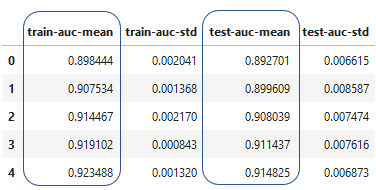Cross validation for credit models
Credit Risk Modeling in Python

Michael Crabtree
Data Scientist, Ford Motor Company
Cross validation basics
- Used to train and test the model in a way that simulates using the model on new data
- Segments training data into different pieces to estimate future performance
- Uses
DMatrix, an internal structure optimized forXGBoost - Early stopping tells cross validation to stop after a scoring metric has not improved after a number of iterations
How cross validation works
- Processes parts of training data as (called folds) and tests against unused part
- Final testing against the actual test set
1 https://scikit-learn.org/stable/modules/cross_validation.html
Setting up cross validation within XGBoost
# Set the number of folds
n_folds = 2
# Set early stopping number
early_stop = 5
# Set any specific parameters for cross validation
params = {'objective': 'binary:logistic',
'seed': 99, 'eval_metric':'auc'}
'binary':'logistic'is used to specify classification forloan_status'eval_metric':'auc'tells XGBoost to score the model's performance on AUC
Using cross validation within XGBoost
# Restructure the train data for xgboost
DTrain = xgb.DMatrix(X_train, label = y_train)
# Perform cross validation
xgb.cv(params, DTrain, num_boost_round = 5, nfold=n_folds,
early_stopping_rounds=early_stop)
DMatrix()creates a special object forxgboostoptimized for training
The results of cross validation
- Creates a data frame of the values from the cross validation
Cross validation scoring
- Uses cross validation and scoring metrics with
cross_val_score()function in scikit-learn
# Import the module
from sklearn.model_selection import cross_val_score
# Create a gbt model
xg = xgb.XGBClassifier(learning_rate = 0.4, max_depth = 10)
# Use cross valudation and accuracy scores 5 consecutive times
cross_val_score(gbt, X_train, y_train, cv = 5)
array([0.92748092, 0.92575308, 0.93975392, 0.93378608, 0.93336163])
Let's practice!
Credit Risk Modeling in Python



